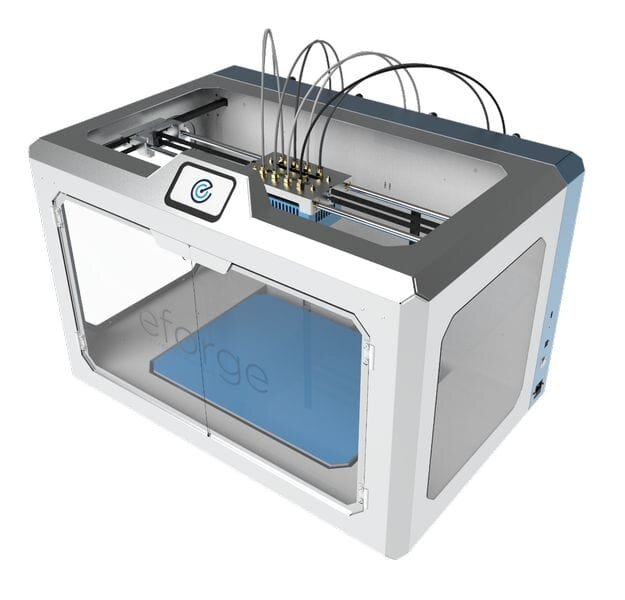![The eForge electronics 3D printer [Source: Electronic Alchemy]](https://fabbaloo.com/wp-content/uploads/2020/05/image-asset_img_5eb08e3481056.jpg) The eForge electronics 3D printer [Source: Electronic Alchemy]
The eForge electronics 3D printer [Source: Electronic Alchemy]
I’m looking at a Kickstarter launch for the new eForge 3D printer, which apparently can 3D print electronics.
This device is quite a bit different from normal filament-based 3D printers, yet it is also familiar in many respects. The main difference is in the new materials developed by Electronic Alchemy.
eForge Materials
The proprietary filament materials are apparently for producing different types of electronic components. Here are the specialized types:
-
Conductive
-
Insulative
-
Capacitive
-
Resistive
-
N-Type Semi-conductive
-
P-Type Semi-conductive
Really, these six materials are all the basic components to make almost any type of electrical circuit, so long as the 3D printer can print small enough to make it.
eForge Filament
This leads to the next interesting feature: extruders. The eForge has EIGHT separate extruders. As you might have guessed by now, six of the eight are for the aforementioned electronics materials.
![Eight spools on the back of the eForge electronics 3D printer [Source: Electronic Alchemy]](https://fabbaloo.com/wp-content/uploads/2020/05/image-asset_img_5eb08e34d1102.jpg) Eight spools on the back of the eForge electronics 3D printer [Source: Electronic Alchemy]
Eight spools on the back of the eForge electronics 3D printer [Source: Electronic Alchemy]
But what about the other two extruders? They are to be used for conventional 3D print materials, including PLA, ABS, PETG, PC, HIPS, Flexible and Composite materials.
What is extremely curious is that the filament diameter for these materials is 3.00mm. Not the de facto industry-standard 2.85mm, but exactly 3.00mm. I find this very strange as the 3.00mm format is basically dead at this point, as I’ve even seen filament distributors selling off their 3.00mm spool stock at giveaway pricing. And even then no one wants the stuff.
Electronic Alchemy apparently developed the electronics materials in conjunction with NASA on some unnamed venture. The company says while they manufacture the machine “frame” in China, the materials are developed in Houston, which just happens to be a major NASA site.
eForge Extrusion System
The extrusion system for the eForge is unusual in that it must include eight nozzles.
These are arranged in a 2 x 4 configuration, and it appears that each nozzle can be raised or lowered slightly. This is a good idea, as inactive nozzles can often interact negatively with an in-progress 3D print if they remain at the same level.
![Touchscreen on the eForge electronics 3D printer [Source: Electronic Alchemy]](https://fabbaloo.com/wp-content/uploads/2020/05/image-asset_img_5eb08e35130f3.jpg) Touchscreen on the eForge electronics 3D printer [Source: Electronic Alchemy]
Touchscreen on the eForge electronics 3D printer [Source: Electronic Alchemy]
Electronic Alchemy says the eForge can achieve a layer size of as low as 0.02mm, which is on par with the best filament 3D printers on the market today.
It also includes an auto-leveling function and a color touchscreen.
![Smart nozzle mount for the eForge electronics 3D printer [Source: Electronic Alchemy]](https://fabbaloo.com/wp-content/uploads/2020/05/image-asset_img_5eb08e355556a.jpg) Smart nozzle mount for the eForge electronics 3D printer [Source: Electronic Alchemy]
Smart nozzle mount for the eForge electronics 3D printer [Source: Electronic Alchemy]
While I have not seen the eForge in action, the auto-leveling feature must be quite interesting to watch, as it must ensure that all eight nozzles have an appropriate Z-gap. This is quite unlike single-nozzle 3D printers, which require only a single Z-gap measurement.
The eight nozzles seem to be held in a fixed carriage that likely ensures they are positioned at a known distance from each other. This is a critical calibration, since if it is off, different materials will not be aligned in the 3D print.
eForge Benefits
![A functional lamp, apparently 3D printed in one operation on the eForge electronics 3D printer [Source: Electronic Alchemy]](https://fabbaloo.com/wp-content/uploads/2020/05/image-asset_img_5eb08e3598707.jpg) A functional lamp, apparently 3D printed in one operation on the eForge electronics 3D printer [Source: Electronic Alchemy]
A functional lamp, apparently 3D printed in one operation on the eForge electronics 3D printer [Source: Electronic Alchemy]
The promise of the eForge is that you could theoretically be able to 3D print, in one piece, simple electronic functional objects. For example, a pressure sensor, or a temperature gauge. One of their examples is a glove, with a sensor 3D printed directly on to the fabric. If this system works, this is a significant capability.
There isn’t much said about software, and that’s where I think the challenge would be with this device. In order to prepare a design for a working circuit, you must literally lay down electrical traces, perhaps even in three dimensions! I’m not sure what software can do that, so you are likely going to be doing it manually. This could constrain the capabilities of the hardware quite a bit.
eForge Pricing
As for pricing, the eForge 3D printer’s list price is said to be US$7,999, but on the launch it is discounted heavily by over US$3,000.
One thing I’m wondering about is the cost of materials.
Electronic Alchemy says they can offer a materials kit for US$400 list price (discounted during launch) but it is not clear how much material is actually on the rather small-looking spools. In other words, the electronic filaments may be pricey. On the other hand, you likely won’t need much.
Finally, as this is a Kickstarter launch by what appears to be a new company, caution is recommended. The eForge is a very ambitious device with lots of moving parts that could go wrong.
In addition, the relatively higher price of the device (as compared to many low-cost launches of conventional 3D printers), means buyers face higher risks. You might want to read our advice for buying new 3D printer launches here.
Via Electronic Alchemy and Kickstarter

